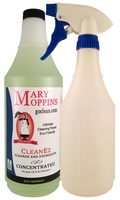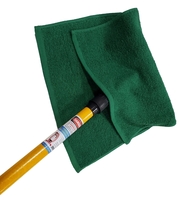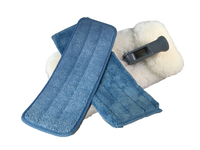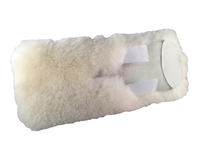Go Green
Toxic Chemicals Found in the Home
After reading the following list of toxic chemicals that you are unknowingly exposing yourself to everyday, hopefully you will be encouraged to hit the green road. The process of switching to green can be a bit overwhelming. Take inventory of all the toxic products in your home and each month switch them to concentrated organic cleaners. If you want a good test of the difference going green can make, buy organic dishwasher detergent. My sinuses cleared up when I made the switch.
Keep these thoughts in mind:
1) Terms like biodegradable, eco-friendly and even “green” may not be a true indication of the bottle contents. Product labeling is not controlled by the government and companies can say whatever they want on a label although gains are being made outlawing false labels.
2) Just because a product is biodegradable does not necessarily mean it's human or earth friendly. Hundreds of compounds including triclosan biodegrade into far more hazardous compounds than what they actually are. Triclosan has been found to degrade into a form of dioxin or Agent Orange. Some products like formaldehyde, may take 500 years or more to biodegrade yet it is labeled biodegradable.
3) Product manufacturers are not required to list any of the chemicals on their labels. If they are listed, and the product is not certified as organic, the toxic chemicals are usually omitted.
4) Learn to read and decipher a Material Safety Data Sheet (MSDS) like a detective. Never use a product if it has more than one health rating with a #2 or above. The toxicity levels on an MSDS sheet are rated 1 through 4, 4 being the most toxic. Find an MSDS sheet by typing "MSDS for say "Simple Green" into a web browser. The sheet will come up.
5) The three products on the “Most Wanted” of the high toxic list are: Drain Cleaners, Oven Cleaners, and acid-based Toilet Bowl Cleaners. Any product labeled DANGER, CORROSIVE, CAUTION or WARNING are best left on the store shelf. They are a high to medium range toxin and there are safe, effective alternatives.
Here is a list of the most toxic chemicals. Avoid them for a healthier life:
Dioxin is formed as an unintentional by-product of industrial processes involving chlorine such as waste incineration, chemical manufacturing and paper bleaching as well as backyard waste burning.
Did you know if you are on a city water system that uses bleach to kill bacteria in the water, which they all do, you are showering every morning with Agent Orange? The chlorine bleach extracts the petro-chemicals out of plastic pipes to form dioxin. Put a filter on your shower and run your drinking water through a filter as well. Dioxin is the primary toxic component of Agent Orange and was found at Love Canal in Niagara Falls, NY, Times Beach, MO and Seveso, Italy when those cities had to be evacuated.
In addition to cancer, exposure to dioxin can also cause severe reproductive and developmental problems (at levels 100 times lower than those associated with its cancer causing effects). Dioxin is well-known for its ability to damage the immune system and interfere with hormonal systems causing birth defects, infertility, endometriosis, diabetes and a host of other ailments.
6) The following are a few of the more well-known chemicals in your everyday cleaners – take them to the toxic waste dump. Then buy Mary’s book "The Complete Idiots Guide to Green Cleaning” for a long healthy life. You will be amazed the difference it makes in your health.
Tub, Toilet and Shower Cleaners: Chlorine bleach, ammonia and ammonia chlorides, Diethylene glycol monobutyl ether, glycosides, hydroxides, glycosides.
All Purpose Cleaners: Ammonia, chlorides, butyl cellusolve or 2-butoxyethanol, bleach, , diethanolamine, ethers, ethylene glycol, hydroxyacetic acid, naphtha, petroleum distillates, phenols, hydroxides, Trisodium phosphate or TSP
The Mister Clean Erasers contain Formaldehyde-Melamine-Sodium Bisulfite Copolymer. Very toxic chemicals.
Laundry Detergents: Linear alkyl sodium sulfonates or sulfates; any of the phenol group; any of the thanolamines; Sodium silicate; sodium hypochlorite; triethylene glycol; Trisodium nitrilotriacetate. Do not use any product containing Phosphate. Many powdered laundry detergents contain fillers, which usually is sawdust. No wonder your towels smell, your clothes don’t come clean and your skin itches. I personally like the BioKleen laundry and dish soaps.
Liquid Dish Soaps: Choloro-o-phenylphenol, Naphtha, Phosphoric acid and soda ash, Sodium sulfites, Ethanol or Ethyl Alcohol which can be combustible. All are cancer causing agents.
Stain Removers: Dipropylene glycol metayl ether, Ethoxylated alcohol, sodium dodecylbenzene sulfonate, glycol ether, nonoxynol 4 and 9, petroleum solvents, sodium hydroxide Beauty Products: Propylene Glycol - the major ingredient in brake and hydraulic fluid: Mineral Oil and Petroleum distillates are used as a metal cutting fluid; Sodium Fluoride - Rat poison, It’s in your toothpaste; Sodium Laurel Sulfate, Cocoamide DEA, TEA, MEA, , diethanolamine, triethanolamine are sudsing agents and are carcinogens. Bentonite or Kaolin Clays in foundations that may clog and suffocate the skin.
Bar Soaps: Made from animal fat and lye. Clogs pores and drains, dries the skin and causes allergic reactions. ALBUMIN and BENTONITE, BIOTIN (Vitamin H is worthless in cosmetics; COLLAGEN – the molecules are too large to penetrate the skin so they suffocate it; LAURAMIDE DEA, Diethylolamine, Triethylolamine are sudsing agents like Sodium Laurel Sulfate. Did you know that the beauty products you use do not require pre-market safety tests for any toxic chemicals?
Air Fresheners. Most numb your sinuses so you can no longer smell the odor. Others mask the odor with toxic fragrances. When anything is sprayed in the air those droplets stay in the air for several days.
Here is a list of the most toxic chemicals and the health issues they cause:
Aphtha can cause confusion, headaches, lack of concentration, and symptoms of mental illness.
Butyl cellosove is highly toxic as is sodium nitrite.
Choloro-o-phenylphenol found in liquid dish soaps is also toxic and a metabolic stimulant. Diethanolamine in liquid dish soaps can cause liver poison.
Dioxins discussed above are not flushed out by the body by the liver. It bio-accumulates in the body’s adhering to fat cells. There is enough dioxin in bleached coffee filters to exceed acceptable levels according to the EPA. Dioxins are also stored in animal fats, full fat dairy products, fatty fish like salmon, trout, tuna and produce that uses pesticides. Paper plates leach it into food and bleached feminine products contain dioxins.
Fluoride ingested in excessive amounts can cause various maladies like constipation, rheumatism, arthritis, chronic fatigue, heart disease and cancer. There are many other more dangerous chemicals, besides fluoride, that are also put in the toothpastes. Most of the toxic chemicals are not even listed on the tubes of toothpastes.
Formaldehyde is off gassed by particle board, plywood, wood cabinets and composite wood products as well as some furniture.
Flame retardants found in computers, television sets, carpeting, bedding and baby clothes are off gassed into the air and cause a dizzying array of ailments.
Naphtha, found in many products and is a hazardous waste. It depresses the central nervous system causing headaches, lack of concentration, confusion, and symptoms of mental illness.
Nonylphenol ethoxylates, and their relatives octylphenol ethoxylates, are widely used in hair colors, shampoos, and hair styling aids. They are often identified as nonoxynol or octoxynol. Nonoxynol-9 is also commonly used as a spermicide.
Phosphoric acid and soda ash Very toxic. Hazardous in case of skin contact, eye contact, ingestion or inhalation. Corrosive to eyes and skin. Over exposure can even cause death.
Phthalates are plastic-softeners, used in nail polish, anti-aging creams, perfumes, shampoos, deodorants, sunscreens, and conditioners, vinyl furniture and flooring, Greenpeace is campaigning for a ban. They are suspected of disrupting the development of the testicles, reducing sperm counts, and damaging the liver and kidneys. The phthalates in vinyl has been linked to cancer, organ damage, asthma, allergies ans a host of other problems. It is that “new car” smell. Don’t buy anything that contains the letters “phth.”
Sodium laurel sulphate or SLS is the most harmful ingredient in personal-care products. SLS may cause potentially carcinogenic nitrates and dioxins to form in the bottles of shampoos and cleansers by reacting with commonly used ingredients found in many products. Large amounts of nitrates may enter the blood system from just one shampooing. It compromises the immune system. It penetrates into the eyes as well as brain, heart, liver, etc., and showed long-term retention in the tissues or bio-accumulating. Sodium sulfites can cause death in asthmatics.
TSP or Trisodium Phosphate found in cleaners, laundry products and now even toothpastes and rinses especially those meant to save gums and for gingivitis. It is extremely toxic and hazardous. Rather than vinyl floor covering and furniture opt for linoleum, wood or stone flooring. Leather is more expensive but does not come with the toxic fumes of vinyl. Vinyl contains phthalates that gas and clings to other fabrics like Scotch Guard treatments and flame retardants in carpet, furniture and bedding.
This article may only be used giving full credit to Mary Findley and her website www.goclean.com.
About Mary
Mary Findley is a veteran cleaning expert and Founder of Mary Moppins. Mary built the company on the idea that she could create a way to make green cleaning easier, which inspired her to co-author "The Complete Idiots Guide to Green Cleaning" available on Amazon. The Mary Moppins line of specially designed cleaning tools are eco-friendly, yet industrial strength to give you the cleaning power you need to clean quickly and thoroughly.




